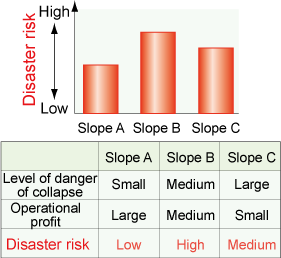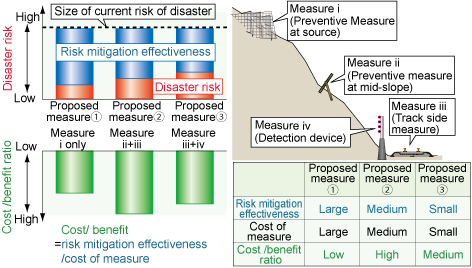8. Risk-assessment based method to assist rational selection of slope-disaster countermeasures
- A system was designed to assess the risk of slope failure or rock fall disaster.
- The outcome of the evaluation can be utilized to rationally prioritise and define the nature of disaster prevention measures to be taken.
An approach has been designed which uses risk as the sole indicator to assess danger of a slope failure or rock fall disaster occurring.
This method assists a rational and quantitative decision making process to set the priority and nature of disaster prevention measures to be taken.
In the case of a slope failure, slope conditions are employed to obtain the probability of collapse, and expected rainfall frequency etc are utilized to calculate an expected failure occurrence rate, which in turn is combined with various types of damage caused at the time of the disaster to yield a risk (Fig 1). For a rock fall, risk is calculated on the basis of damage caused in the case of a disaster, associated with the probability of blocks falling onto the track which is found through motion simulation, together with the state of health of the mass of rock in the fall.
By camparing the risk obtained from the abovementioned method for the slope failure and the rock fall, disaster prevention measures can be quantitatively selected and ranked for track sections adjoining slopes (Fig 2). Furthermore, the pre- and post-countermeasure risk factor for each slope in question can be compared with the cost of the measures. This permits the calculation of the cost-benefit ratio and risk mitigation effectiveness of the measures which in turn facilitates the development of a rational disaster prevention plan (Fig 3). Finally, a user guide illustrated with actual calculations and examples was compiled in order to facilitate use of this method by railway professionals.
 Fig. 1 Flow chart for calculating risk of slope failure disaster
Fig. 1 Flow chart for calculating risk of slope failure disaster Fig. 2 Current comparative risk of disaster
Fig. 2 Current comparative risk of disaster Fig. 3 Risk mitigation effectiveness according to measure
Fig. 3 Risk mitigation effectiveness according to measure
(rock fall measure example)